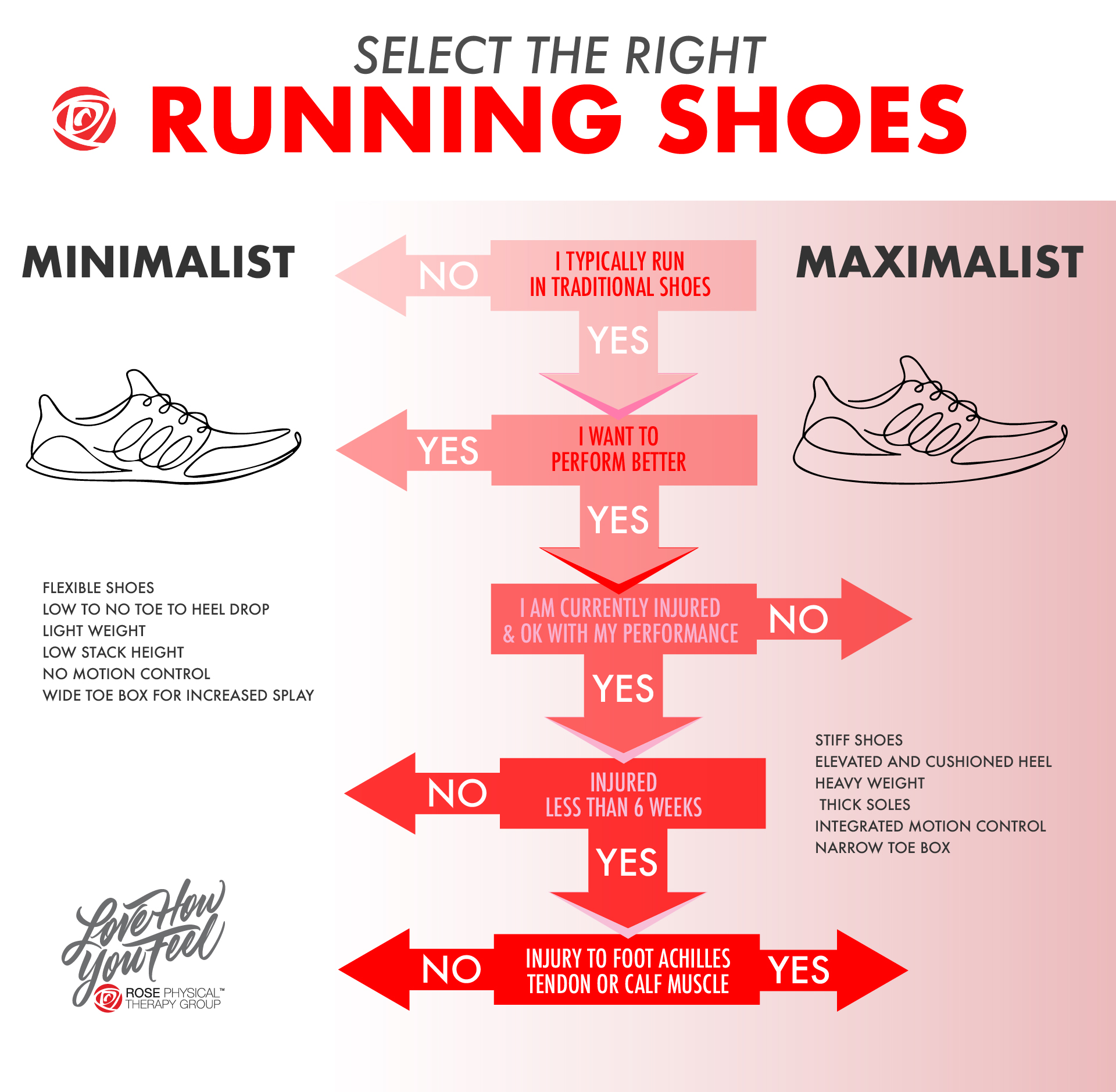Consider using minimalist shoes if you are not injured and want to improve your performance.
Sooner or later most runners question whether they should move to a minimalist shoe. As physical therapists in Washington, DC which has a large running community, we often encounter this question. The decision might seem daunting at first. On one hand, maybe you’ve always been fine with “normal” running shoes. On the other hand, you’ve heard that minimalist shoes are superior.
The goal of this article is to provide sound physical therapy advice to help guide your shoe buying decision.
Negative aspects of conventional running shoes
Shoe companies and biomechanics researchers used to evaluate the cushioning of a shoe by measuring the impact force on a weight dropped from a standard height onto the heel of the shoes. Running shoes were then designed to have thicker soles to help protect your feet and give you cushioning. It is now known that thicker shoe soles are damaging to many athletes.
Thick shoe soles cause more joint impact, increase the amount of effort expended for moving your feet, cause foot muscle atrophy and arch collapse, increase injury frequency, and can cause knee problems.
- Joint impact: Excessive shoe cushioning is deceptive because it makes us think we are reducing joint impact, but it is merely reducing the sensation of the impact. Excessive shoe cushioning can be hugely detrimental to our joints and tissues because it allows us to be sloppy with our footfalls or foot placement, and it allows us to slap our feet down with tremendous force without any perceived consequences. When we fail to place our feet just right, our weight is distributed poorly and our heels, toes, and arches are not able to properly absorb impact and distribute body weight. This can have negative implications for our feet, ankles, knees, back, and so on, all the way up the kinetic chain. When we are barefoot or wearing only thin-soled, flexible footwear, our feet and bodies can feel the ground and provide biofeedback on our lower extremities. As a result, minimalist shoes or bare feet footfalls tend to be gentler and more mindful, seeking out the smoothest path over which to move forward, and is healthier for our joints and tissues.
- Increased effort: cushioned soles actually force us to do more work with each footfall. The greater the cushioning or sponginess in a shoe, the less efficiently force is transferred between the foot and the ground. Energy that would otherwise go into pushing off is dispersed throughout the shoe’s padding and wasted, similar to running in sand. With bare feet or minimalist footwear, a maximum amount of propulsive energy is transferred between the foot and the ground during the toe-off phase of gait, and considerably less energy is wasted with each step or stride.
- Foot muscle atrophy and arch collapse: Although conventional athletic shoe have springy cushioning, the thickness of the soles results in greater sole rigidity, which can have detrimental effects on foot muscle strength and arch integrity. Wearing thickly-cushioned, rigid-soled footwear immobilizes your feet and allows them to slowly deteriorate and atrophy. Immobilized feet lose muscle tone and their ability to generate force, reducing foot function and putting more pressure on other muscles to make up the difference, which can lead to a breakdown of the kinetic chain. Although doing high-impact activities in shoes with no or only minimal cushioning can, in some cases, feel uncomfortable, but this isn’t necessarily a bad thing because it encourages a reassessment of how we’re performing an activity. Minimalist shoes promote healthy movement while maintaining muscle tone.
- Increase injury frequency: By reducing the ability of foot muscles to exert force through the foot strike and inhibiting biofeedback to alert a rujnner to improper running form, conventional shoes result in greater pressure on the entire kinetic chain. This can cause injuries to knees, hips and even your back and neck. The greater the frequency of bad form used in running, the greater the frequency of injury.
- Increasing knee injury: Runners using conventional shoe cushioning, or excessive cushioning in some brands of shoes, are more likely to adopt a heavy impact running style that puts a great deal of pressure on the knees. Without distribution of forces through the foot, the knee is the next part of the kinetic chain that must absorb the forces being exerted. In contrast, barefoot runners or runners using a minimal shoe tend to adopt a gentler, impact-mitigating midfoot strike that allows the arches and ankles to contribute better to shock absorption. With more joints handling the shock, the forces get more evenly distributed between the lower extremity joints.
What is a minimalist shoe and is it right for me?
There are three questions to consider in choosing to use minimalist shoes: am I happy with my current running? Am I injured? Do I want to improve my performance?
- Am I happy with my current running? If you hare happy with your current run performance and do not want to change anything, do not change to conventional shoes just to do it.
- Am I injured? If you are injured this is not a great time to change to a completely new shoe. Work with your Rose physical therapist here in Washington, DC to determine if minimalist shoes can help with your injury recovery, or hinder it.
- Do I want to improve run performance? By properly distributing the force of foot strike and allowing for direct muscle power to push from the ground, minimalist shoes can enhance running performance.
A minimalist shoe is footwear that provides minimal interference with the natural movements of the foot due to high flexibility, low heel to toe drop, weight, stack height, absence of motion control and stability devices, and a wider toe box to allow for natural toe splay.
Weight: the lighter the shoe the more minimal it is.
Stack height: measured at the center of the heel it shoes the distance between your heel and the most external part of the outsole underneath. The thinner the show, the more minimal it is.
Heel to toe drop: the difference between the shoe thickness under your heel to where your toes start. The closer to 0 this difference is, the more minimal the shoe is.
Stability and motion control: this measures the most commonly used technologies to control pronation, the least amount of technology means the more minimal.
Flexibility: the shoe is tested for forward/backward flexibility by bending the front part of the shoe towards the heel. It is also bend in a torsional or side to side motion for the front of the shoe. The more the flexibility, the higher the rating.
Toe splay: The shoe has a wider toe box allowing for more toe splay. Toes that are splayed well apart confer a large degree of protection from the impact forces experienced during weight-bearing activity by spreading the impact forces out over a larger surface area.

Considerations in evaluating and purchasing minimalist shoes
Although minimal shoes are considered to reduce injury and improve performance, they also include some negative aspects. For instance, minimal shoes create greater impact on your foot and this can increase injury in your metatarsals.
While it is easy to mitigate injuries in your lower extremities that can result from the sudden use of minimalist shoes, this adjustment might require a change in running frequency and/or distance to allow your body to adapt. Changing to minimalist shoes might also require you to change your running form, and this can take time.
It is also important to note that minimalist shoes are not created equal. Due to production considerations, marketing considerations, and other practical factors, many shoe companies choose to not produce zero drop shoes which have a sole that is equal thickness from front to back. To compare shoes, we suggest using the following measurements as a guide.
Rose Physical Therapy is here in Washington, DC to help!
If you have a history of any running related, or lower body injury, or have any questions on running form, shoe selection, or are looking to enhance performance, set up at appointment at Rose Physical Therapy. We offer appointments at either our office in downtown Washington, DC office between Dupont Circle and Farragut Square, or at our office in Navy Yard and Capitol Riverfront, just a few blocks from Capitol Hill.
If you have any questions about your running form, please be sure to inquire about our running analysis. We have developed our running analysis program to be the gold standard in running analysis, as the most effective at improving your performance and reducing injuries.


